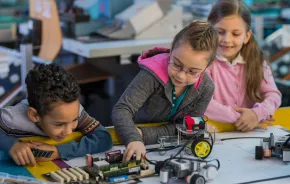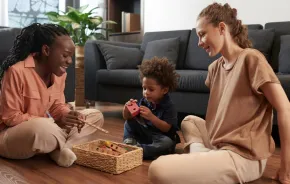 Summer will be here before we know it. Many children look forward to an exciting summer camp they get to attend – but what if camp isn't an option for your family? Perhaps it's not in your budget, or your kids have special needs or are not ready for longer periods away from home.
Summer will be here before we know it. Many children look forward to an exciting summer camp they get to attend – but what if camp isn't an option for your family? Perhaps it's not in your budget, or your kids have special needs or are not ready for longer periods away from home.
One solution: Design a summer camp experience at home, which can be affordable, fun, and easier than it sounds to pull off.
Here are six types of DIY summer camps to inspire you, as well as practical tips from creative parents and grandparents who have successfully "home-camped."
1. Theater camp
2. Science camp
3. Art camp
4. TV show theme camp
5. Day camp at a park
6. Overnight camp
 Theater Camp
Theater Camp
Do you have a dramatic child who would love a chance to perform? A theater camp could be a great way to introduce your kid to the thespian experience without the pressure of performing for strangers.
Amy Erickson, a Seattle mother of three, put on a Reader’s Theater camp at her house, working with a total of 12 children, including her own, for four days. She picked a children’s book with a strong story and enough characters for all the children to play parts. Amy led the children through set design, stage direction, props and acting. The kids made their own costumes from fabric and basic pieces from a thrift store. On the final day, the children performed their masterpiece in the yard for their parents and neighbors.
Key ingredients: Amy picked the book Mama Panya’s Pancakes by Mary and Rich Chamberlain. She provided big cardboard boxes for sets, a curtain, clothing and jewelry from thrift stores, art supplies and a love of theater. Amy asked for a $20 donation per child for supplies.
Tips for success: Amy acted as the narrator of the production. Some of the kids wanted to learn their lines, but for those who didn’t, she was available to read their parts while the children acted.
Resources: Amy used games and activities from the Creative Drama and Resource Site. Read another mom’s take on a lakeside theater camp she developed, hiring teenagers to lead it.
Next: Science camp
(Photo courtesy of Amy Erickson)
 Science Camp
Science Camp
Science-loving kids will enjoy a chance to run experiments and learn about the natural world. Olympia, Washington, mom Victoria Gehring did a three-day camp with her homeschool co-op group. “Each day had a theme,” she says.
Topics covered included light and color, water and life cycles, and aerodynamics and rockets. Twelve children participated in their camp, which was held at one family’s home. Each day they did about four activities, and tried to include some videos as well. They made UV bracelets, constructed models of molecules, tested chemical reactions to make explosions, dissected owl pellets, made boats to float, built and flew rockets and tested paper airplanes.
Key ingredients: A spirit of exploration is handy for scientific inquiry. Consider also getting child-sized safety goggles for each participant to wear during experiments.
Tips for success: Victoria was firm about not allowing children younger than 5 to be on the premises due to safety concerns.
Resources: The Internet is full of science experiments for children. Try Science Buddies for tons of ideas and kits. Acorn Naturalists carries all kinds of nature study tools, including owl pellets for dissection. The American Chemical Society has free chemistry curricula for preschool, elementary and middle school children outlining multiple interesting experiments using safe household ingredients. There are also many books you can check out that have collections of age-appropriate science ideas. Safety Glasses USA is one company that sells protective eye-wear for youth.
Next: Art camp
 Art Camp
Art Camp
Isolde Beebe missed her career as a high school art teacher, so when her kids were old enough she started her own art camps in her garage for them and their friends. She has organized camps with several themes over the years, such as the Art of Recycling, Meet the Masters, Fairytale Art, Clay and Sculpture and Art Around the World. She generally teaches five mornings for a week and charges about $10 an hour plus supplies. Her camps have grown over the years, and she recently moved them to a larger community space and hired a second teacher. (She lives in Mill Creek, Washington.)
Key ingredients: Camp organizers should bring a love of art and a willingness to get messy. Higher-quality art supplies will help kids be more successful and satisfied with the process.
Tips for success: Isolde tried the projects with her own children first to see if they worked. She only used projects she loved.
Resources: Isolde recommends DK Publishing’s Children’s Book of Art; My Art Book, Lives of the Artists by Kathleen Krull and Kathryn Hewitt; and Katie’s Picture Show by James Mayhew. For other great ideas, check out the book Great American Artists for Kids by MaryAnn Kohl. The inspiring website The Artful Parent by Jean Van’t Hul is chock full of hands-on projects.
Next: TV show theme camp
 TV Show Theme Camp
TV Show Theme Camp
A favorite TV show can also be a suitable theme for a camp, as Battle Ground grandmother Doreen Turpen found. She organized a Dragon Tales camp for her grandchildren one year. The PBS show captured the children’s imaginations and inspired many crafts and activities. It was also a chance for the grandparents to spend a long weekend with their grandkids, and for the cousins to build their relationships.
Doreen sent special invitations in the mail to the children, and created T-shirts with dragons printed on them using transfer paper. She used the Internet and books to plan crafts, stories, games and art projects around the theme of dragons, and allowed for plenty of play time as well. She sent the kids home with a simple memory book filled with photos of their time together.
Key ingredients: Provide lots of raw materials for the children to create their own world – art supplies, paper, and scrap or recycled materials, as well as costumes.
Tips for success: Doreen says, “I learned not to overly structure [the kids’] time together. And we provided time for them to be apart…to follow their individual interests.”
Resources: If you choose a PBS show, you can find activities and educational extensions for many shows on pbs.com. Do an Internet search to find free printable coloring pages, clip art, and other activities for many popular TV shows and movies. Check your local library to see if there are any books that tie-in with the show.
Next: Day camp at a park
 Day Camp at a Park
Day Camp at a Park
One obstacle parents might face in planning a summer camp for their children and friends is the space required. Seattle Mom Lina Trujillo’s PEPS group solved this by meeting at a different park each afternoon for two weeks. After they ate their picnic lunches, they would have a guided activity like a bug hunt, berry picking, gathering shells, or hiking. One parent led the children in making journals to use throughout their camp experience. Other ideas they used were flower pressing, sun prints, rock rubbings and decorating camp T-shirts. Each day also included free play time. The parents took turns leading and providing snacks and activities. They didn’t charge a fee because they each were in charge of a week.
Key ingredients: Find out ahead of time if there will be tables, running water, restrooms and other amenities at the parks you plan to visit.
Tips for success: Use the natural environment of the park to guide the events you choose. Remind the parents to pack sunscreen for the children.
Resources: For more ideas, check out the book I Love Dirt by Jennifer Ward and the classic environmental education books by Joseph Cornell, including Sharing Nature with Children.
Next: Overnight camp at home
(Photo courtesy of Lina Trujillo)
This isn't for everyone, but Renee Bergeron shows it can be done. She and her family put on an overnight camp experience for her 14 children and their friends – about 30 kids in total. They knew they would not be able to afford a traditional overnight camp, and they wanted to provide that experience for them. They hosted the children on their five-acre property near Bellingham, Washington, for three days and two nights. The kids were split into teams of mixed ages and they slept in tents supervised by adults.
Activities included beading and leather working, camping skills workshops, campfires, team games, water balloon fights, team posters and knot tying. A favorite activity was Invention Bags. Renee explains: “Each team was given a bag of random items and had to ‘invent’ something and then come up with a commercial to sell it.” To streamline snack time, they  had a Snack Shack with food the kids “bought” with tickets they earned by doing their dishes. The Bergerons charged between $12 and $18 per child to cover expenses.
had a Snack Shack with food the kids “bought” with tickets they earned by doing their dishes. The Bergerons charged between $12 and $18 per child to cover expenses.
Key Ingredients: Craft supplies, camping equipment and even a campfire (if legal) will make your experience more authentic. Don’t forget the camp T-shirts!
Tips for success: “Structure and routine were our best friends!” Renee says. “We had the schedule posted in several places so everyone knew what to expect.” After the first year, she realized it was important to have all the parents involved to keep everyone on track.
Resources: You can see photos of three years of camps and activities on Renee’s blog. For more ideas of activities to keep your campers busy, check out the book Kids Camp! Activities for the Backyard or Wilderness by Laurie Carlson and Judith Dammel.
(Photos courtesy of Renee Bergeron)
About the author: Jennifer Johnson looks for any excuse to escape into nature with her children. She blogs about hiking with children at thehikermama.com and is a frequent contributor to ParentMap.












